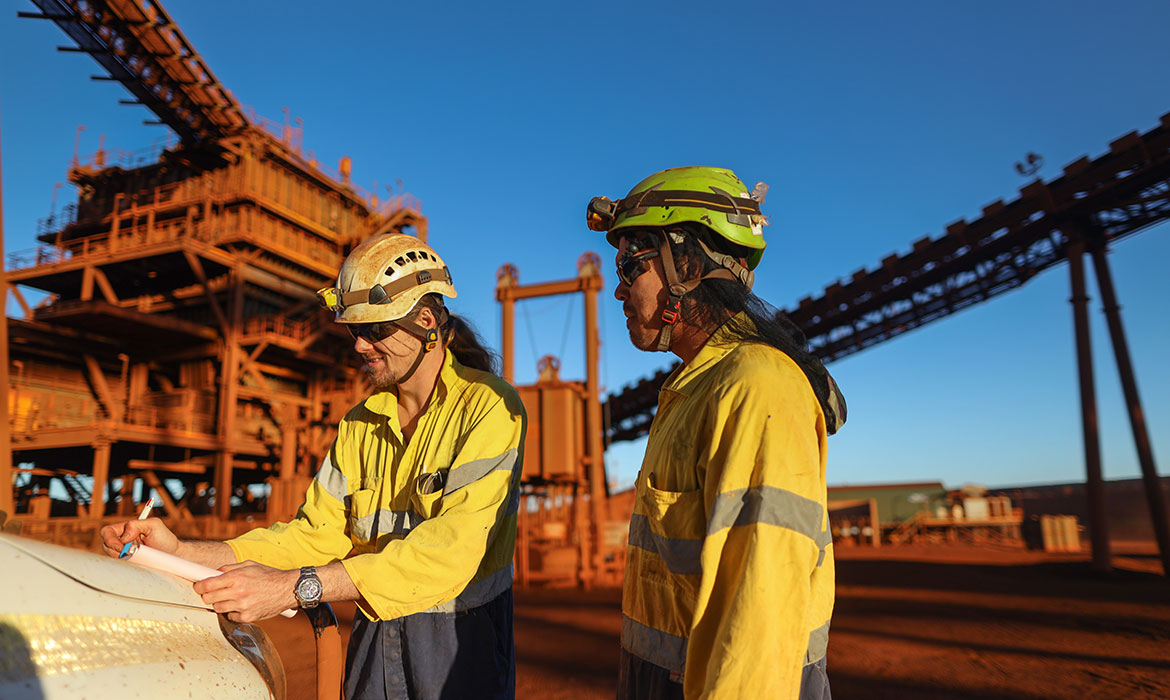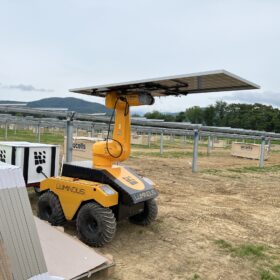From Energy Renaissance.
Accounting for up to 30% of a total mine site’s expenditure, energy has always represented a critical point of vulnerability for the sector. The mining sector derives most of its energy from diesel (41%), natural gas (33%), and grid electricity (22%), with the remainder supplied by a mixture of other refined fuels, coal, LPG, renewables, and biofuels. Soaring fossil fuel prices have caused the scaling back or closure of Australian mines, resulting in production and job losses at a massive scale. More recently with the added consideration of carbon emissions, energy represents both a risk and an opportunity for this sector.
Just as the energy landscape has itself evolved, mining is in the process of its own metamorphosis with three major, interrelated trends emerging – electrification, digitalisation and automation. A report titled State of Play: Electrification sponsored by the FBICRC and released by Virtual Consulting International on October 28th, showed that 89 percent of the world’s leading mining executives expect mine sites across the world to electrify within the next 20 years. Furthermore, 91% expect the shift to electrics will create new business opportunities.
These trends are evident both here and in overseas markets with industry players aiming to improve brand perception, streamline operations, enhance worker safety, minimise operational expenditure and ultimately, deliver more competitive exports to rival international peers.
What’s driving mining’s shift to renewable energy?
Carbon risk is now an industry-wide performance indicator that has taken up permanent residency in company reporting – investors no longer see environmental sustainability as something that can be overlooked or glossed over. It is not only fiscally responsible to have a decarbonisation strategy, it is simply expected. Other factors driving demand for renewables in mining include:
- Pressure from investors to decarbonise
- CapEx reduction
- Safety improvements and associated reductions in up-front capital costs
- EY’s 2019 Electrification of Mining report outlines some of the dangers of working in confined spaces around diesel equipment. As much as 40% of underground mining’s energy outlay is spent on ventilation systems to remove pollutants from tunnels.
- The WHO now classifies diesel particulates alongside asbestos, arsenic and mustard gas.
- Cheaper access to deposits
- Less resistance from communities, strengthened license to operate
- Increase mine site productivity
So who is playing ball?
BHP has pledged to reduce emissions from its operations by 30 per cent by 2030, adding that it will continue to thrive under net zero emissions in the future.
Fortescue Metals Group (FMG) recently announced its commitment to net-zero carbon emissions by 2040, with an interim target of a 26% operational emissions reduction from current levels by 2030.
Oz Minerals is planning a $1 billion nickel and copper project 500km west of Uluru with a strategy to power those operations with up to 80 per cent wind and solar, supported by battery storage and some fossil fuel generation. It wants to get to 100% renewables and is actively looking for ways to achieve this, whilst targeting net zero company-wide by 2050.
South Africa-based miner Gold Fields has installed 18MW of wind power, 4MW of solar PV, a 13MW/4MWh Saft battery energy storage system and an off-grid 21MW gas/diesel engine power plant at its Agnew gold mine in Western Australia, and has set its sights on a portfolio-wide target of 99% renewables.
Cobalt-nickel-scandium producer Australian Mines Limited has announced plans to become carbon neutral by the end of 2020.
Wheaton Precious Metals Corp confirmed to S&P Global that its operations are already carbon neutral.
Newmont Goldcorp’s all-electric Borden gold mine in Canada started transitioning to diesel-free in 2016 and has seen a 70 per cent reduction in greenhouse gas emissions, reduction in ventilation costs by 50 per cent and reduced megawatt hours of 33,000 annually. Newmont stated that, “Something like 90 per cent of our staff said that they would not want to go back and work in a traditional underground mine alongside diesel engines.”
While not all miners have yet made moves to decarbonise, the rate of adoption is picking up noticeably, and that is a very positive sign.
Challenges & Opportunities
In 2019, EY commissioned a survey of miners and original equipment manufacturers and the key challenges identified were:
Making the right capital investment decisions
The fundamentals are different in conventional mining projects compared with those that use renewables. A renewables-based energy system has high capital expenditure (capex) and low operating expenditure (opex), whereas conventional projects have comparatively low capex and high opex. While it is comparatively easier (and cheaper) to change open-pit operations, it takes a lot of investment to make changes to underground operations. Decisions around making changes will also depend on the stage of the mine cycle — toward the end of mine life, it may not make economic sense to invest.
Ensuring technology remains agile
Miners must recognise the fact that technology will evolve over the years and whatever makes economic sense today might not have similar results five years down the line. Mining and metals continue to lag behind other sectors in the realm of technological effectiveness. The value from technology will only be realised when companies change how they work, rather than succumbing to the lure of individual technology programs and pursuing local optimisation, which is not necessarily transformational.
Renewables are capital intensive but they have very limited operating expenses over the life of the system. Mining companies have the option to either invest in renewable energy themselves or to enter into a medium to long-term Power Purchase Agreement (PPA) with a third party provider. Furthermore, reliability and stability of power supply is of critical importance, particularly in off-grid mining operations, to prevent any temporary reduction in production.
The pros and cons of each renewable energy technology must be considered in the context of the mine site’s specific power supply needs. Maximising renewables is preferable from a financial perspective, but the level of intermittency and resulting instability needs to be balanced with dispatchable supply from batteries or fossil fuels, and coordinated with smart management software.
Thermal Runaway – Mining’s Greatest Risk in Energy Storage Investment
With batteries playing such a critical role in a mine site’s energy supply, as far as system reliability goes, the buck literally stops with storage. Uptime and system performance are key in returning a storage system’s capital investment, and this is where thermal runaway becomes a significant risk factor. This is amplified in mine site applications which are located in notoriously hot remote locations.
Thermal runaway occurs in situations where an increase in temperature changes the conditions in a way that causes a further increase in temperature, leading to underperformance or failure. While the rate of field failure is statistically low, the number of cells deployed in large-scale installations means it’s likely some failure will occur.
An industry standard 1MWh Li-Ion Battery is made up of around 144,000 cells with the statistical potential of 420 cells catching fire at some point in their life. At utility scale, an example such as the Hornsdale Wind Farm in SA which is a 309MWh installation and is made up of approximately 45 million cells, sets the heart racing! While a battery management system (BMS) helps the battery stay within its operating boundaries, it does not protect against internal shorts or improve the quality of cells beyond how they were originally manufactured.
Most lithium-ion batteries perform optimally at around 21C and performance decreases significantly as temperatures rise above 40C. In climates above 25C, ‘parasitical’ power can consume up to 30% of the energy stored in lithium-ion batteries, resulting in higher lifetime costs. This can be significantly reduced with Energy Renaissance lithium-ion batteries, designed specifically for hot climates with proprietary technology that means they have no thermal runaway
Energy Renaissance’s supercell platform employs high energy cylindrical jelly rolls in a prismatic case with proprietary thermal insulation housing enabling increased performance at higher ambient operating temperatures. The thermal isolating housing enables a closely packed jelly roll configuration without cascading failure using a non-combustible material formulation that provides exceptionally high levels of fire retardant. The thermal isolation is sufficient to allow large jelly rolls with no roll-to-roll runaway and optimised electrolyte formula enables improved performance at higher ambient temperatures.
The Renaissance superCell™ technology was recognised in the 2018 Frost & Sullivan Best Practice Awards, with Frost & Sullivan stating, “Independent testing by government research laboratories, as well as economic assessment by DNV-GL, has validated the safety and benefits of this new battery system. The company’s breakthrough innovations dramatically improve performance, reduce costs, and boost safety.”
Safely transitioning mining to a cleaner, more profitable future
The potential of renewable energy to transform mining is monumental. Where in the past, miners have been indefensibly exposed to the price volatilities of fossil fuels, renewables can remove this risk whilst improving brand perception and shareholder value. The transition away from fossil fuels, however, is complex and high-risk.
Smart, high quality renewable technologies with proven reliability will reduce this risk and allow for a smoother integration with the mine site’s operations.
With the industry rapidly making moves to electrify and decarbonise, this momentum will only increase as energy becomes a key point of competitive advantage.
Author: Mark Chilcote
The views and opinions expressed in this article are the author’s own, and do not necessarily reflect those held by pv magazine.
This content is protected by copyright and may not be reused. If you want to cooperate with us and would like to reuse some of our content, please contact: editors@pv-magazine.com.








By submitting this form you agree to pv magazine using your data for the purposes of publishing your comment.
Your personal data will only be disclosed or otherwise transmitted to third parties for the purposes of spam filtering or if this is necessary for technical maintenance of the website. Any other transfer to third parties will not take place unless this is justified on the basis of applicable data protection regulations or if pv magazine is legally obliged to do so.
You may revoke this consent at any time with effect for the future, in which case your personal data will be deleted immediately. Otherwise, your data will be deleted if pv magazine has processed your request or the purpose of data storage is fulfilled.
Further information on data privacy can be found in our Data Protection Policy.